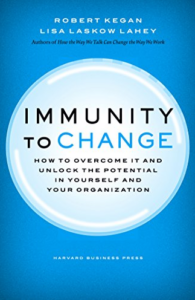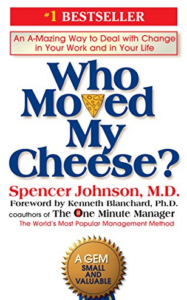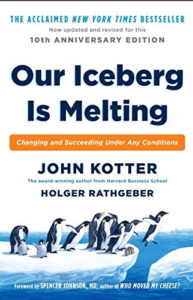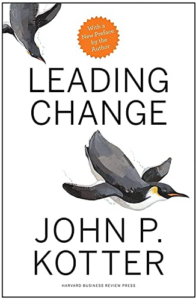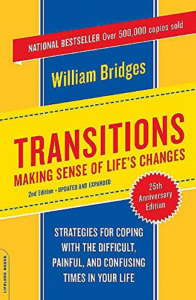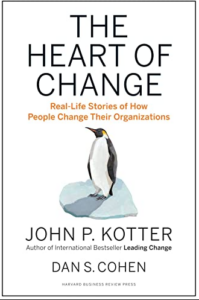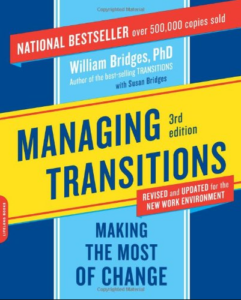Scope out these popular reads on managing change and change management!
Change is a constant in our world. The ability to navigate and effectively manage change is a skill needed at work and at home. One of the most effective ways to gain insights, strategies, and inspiration for mastering the art of change is through the written word. In this blog post, we’ll share some of the most popular books on change management and managing change. These books offer invaluable guidance, practical tools, and thought-provoking perspectives to explore.
1. Immunity to Change: How to Overcome It and Unlock the Potential in Yourself and Your Organization (Leadership for the Common Good)
by Robert Kegan and Lisa Laskow Lahey
This change management book provides insightful lessons about how to unlock our full potential and grow as individuals, team members, and leaders.
Amazon Description:
A recent study showed that when doctors tell heart patients they will die if they don’t change their habits, only one in seven will be able to follow through successfully. Desire and motivation aren’t enough: even when it’s literally a matter of life or death, the ability to change remains maddeningly elusive.
Given that the status quo is so potent, how can we change ourselves and our organizations?
In Immunity to Change, authors Robert Kegan and Lisa Lahey show how our individual beliefs–along with the collective mind-sets in our organizations–combine to create a natural but powerful immunity to change. By revealing how this mechanism holds us back, Kegan and Lahey give us the keys to unlock our potential and finally move forward. And by pinpointing and uprooting our own immunities to change, we can bring our organizations forward with us.
This persuasive and practical book, filled with hands-on diagnostics and compelling case studies, delivers the tools you need to overcome the forces of inertia and transform your life and your work.
2. Who Moved My Cheese?
by Spencer Johnson
A motivational parable that offers insightful lessons about adapting to change, using a simple story of two mice and two little people who must navigate a maze to find cheese, illustrating how individuals respond to unexpected shifts in life.
Amazon Description:
Most people are fearful of change, both personal and professional, because they don’t have any control over how or when it happens to them. Since change happens either to the individual or by the individual, Dr. Spencer Johnson, the coauthor of the multimillion bestseller The One Minute Manager, uses a deceptively simple story to show that when it comes to living in a rapidly changing world, what matters most is your attitude.
Exploring a simple way to take the fear and anxiety out of managing the future, Who Moved My Cheese? can help you discover how to anticipate, acknowledge, and accept change in order to have a positive impact on your job, your relationships, and every aspect of your life.
3. Switch: How to Change Things When Change Is Hard
by Chip Heath and Dan Heath
Drawing on psychology and real-world examples, the authors present a framework for making change easier by addressing both rational and emotional aspects, guiding readers through a process of successful transformation.
Amazon Description:
Why is it so hard to make lasting changes in our companies, in our communities, and in our own lives?
The primary obstacle is a conflict that’s built into our brains, say Chip and Dan Heath, authors of the critically acclaimed bestseller Made to Stick. Psychologists have discovered that our minds are ruled by two different systems—the rational mind and the emotional mind—that compete for control. The rational mind wants a great beach body; the emotional mind wants that Oreo cookie. The rational mind wants to change something at work; the emotional mind loves the comfort of the existing routine. This tension can doom a change effort—but if it is overcome, change can come quickly.
In a compelling, story-driven narrative, the Heaths bring together decades of counterintuitive research in psychology, sociology, and other fields to shed new light on how we can effect transformative change. Switch shows that successful changes follow a pattern, a pattern you can use to make the changes that matter to you, whether your interest is in changing the world or changing your waistline.
4. Our Iceberg Is Melting: Changing and Succeeding Under Any Conditions
by John Kotter and Holger Rathgeber
Through a fable about a group of penguins facing an impending iceberg meltdown, this book offers a step-by-step guide to effective change management, emphasizing the importance of collaboration, vision, and communication.
Amazon Description:
Our Iceberg Is Melting is a simple story about doing well under the stress and uncertainty of rapid change. Based on the award-winning work of Harvard Business School’s John Kotter, it can help you and your colleagues thrive during tough times.
On an iceberg near the coast of Antarctica, group of beautiful emperor penguins live as they have for many years. Then one curious bird discovers a potentially devastating problem threatening their home—and almost no one listens to him.
The characters in the story—Fred, Alice, Louis, Buddy, the Professor, and NoNo—are like people you probably recognize in your own organization, including yourself. Their tale is one of resistance to change and heroic action, seemingly intractable obstacles and clever tactics for dealing with those obstacles. The penguins offer an inspiring model as we all struggle to adapt to new circumstances.
Our Iceberg Is Melting is based on John Kotter’s pioneering research into the eight steps that can produce needed change in any sort of group. After finishing the story, you’ll have a powerful framework for influencing your own team, no matter how big or small.
5. Leading Change
by John P. Kotter
This book outlines an eight-step process for leading successful organizational transformations, offering practical strategies and case studies to help leaders navigate challenges.
Amazon Description:
Millions worldwide have read and embraced John Kotter’s ideas on change management and leadership.
From the ill-fated dot-com bubble to unprecedented M&A activity to scandal, greed, and ultimately, recession—we’ve learned that widespread and difficult change is no longer the exception. It’s the rule. Now with a new preface, this refreshed edition of the global bestseller Leading Change is more relevant than ever.
John Kotter’s now-legendary eight-step process for managing change with positive results has become the foundation for leaders and organizations across the globe. By outlining the process every organization must go through to achieve its goals, and by identifying where and how even top performers derail during the change process, Kotter provides a practical resource for leaders and managers charged with making change initiatives work. Leading Change is widely recognized as his seminal work and is an important precursor to his newer ideas on acceleration published in Harvard Business Review.
Needed more today than at any time in the past, this bestselling business book serves as both visionary guide and practical toolkit on how to approach the difficult yet crucial work of leading change in any type of organization. Reading this highly personal book is like spending a day with the world’s foremost expert on business leadership. You’re sure to walk away inspired—and armed with the tools you need to inspire others.
6. Transitions: Making Sense of Life’s Changes
by William Bridges
Exploring the psychological and emotional aspects of change, Bridges introduces a model for understanding the transitional process, providing insights and tools to manage the discomfort and uncertainty that accompany life’s transitions.
Amazon Description:
Whether you choose it or it is thrust upon you, change brings both opportunities and turmoil. Since Transitions was first published, this supportive guide has helped hundreds of thousands of readers cope with these issues by providing an elegantly simple yet profoundly insightful roadmap of the transition process. With the understanding born of both personal and professional experience, William Bridges takes readers step by step through the three stages of any transition: The Ending, The Neutral Zone, and, eventually, The New Beginning. Bridges explains how each stage can be understood and embraced, leading to meaningful and productive movement into a hopeful future. With a new introduction highlighting how the advice in the book continues to apply and is perhaps even more relevant today, and a new chapter devoted to change in the workplace, Transitions will remain the essential guide for coping with the one constant in life: change.
7. The Heart of Change: Real-Life Stories of How People Change Their Organizations
by John P. Kotter and Dan S. Cohen
Focusing on the human element of change, this book combines real-life stories and research to demonstrate how successful change efforts are rooted in emotional engagement, shared vision, and meaningful communication.
Amazon Description:
The Heart of Change is your guide to helping people think and feel differently in order to meet your shared goals. According to bestselling author and renowned leadership expert John Kotter and coauthor Dan Cohen, this focus on connecting with people’s emotions is what will spark the behavior change and actions that lead to success. Now freshly designed, The Heart of Change is the engaging and essential complement to Kotter’s worldwide bestseller Leading Change.
Building off of Kotter’s revolutionary eight-step process, this book vividly illustrates how large-scale change can work. With real-life stories of people in organizations, the authors show how teams and individuals get motivated and activated to overcome obstacles to change—and produce spectacular results. Kotter and Cohen argue that change initiatives often fail because leaders rely too exclusively on data and analysis to get buy-in from their teams instead of creatively showing or doing something that appeals to their emotions and inspires them to spring into action. They call this the see-feel-change dynamic, and it is crucial for the success of any true organizational transformation.
8. Change Management: The People Side of Change
by Jeffrey Hiatt and Timothy Creasey
A comprehensive guide to change management practices, this book offers practical tools and methodologies to effectively lead people through transitions and enhance organizational success.
Amazon Description:
This book is a solid, research-based introduction to the discipline of change management, and a primer to catalyze change leadership and competency in managers and executives. Change Management is a practical look at what it means to manage the people side of change, and gives the reader insight into best practices in this area.
9. Managing Transitions: Making the Most of Change
by William Bridges
Building on his earlier work, Bridges presents a practical approach to understanding and managing transitions, emphasizing the psychological and emotional aspects of change while providing actionable advice.
Amazon Description:
The business world is transforming. Stories of layoffs, bankruptcy, mergers, and restructuring appear in the news every day. When these changes hit the workplace, the actual situational shifts are often not as difficult for employees and managers to work through as the psychological components that accompany them. Indeed, organizational transitions affect people; it is always people who have to embrace a new situation and carry out the corresponding change.
The job of managing workplace change can be difficult; managed poorly, the result can be disastrous to the morale and stability of the staff. As veteran business consultant William Bridges explains, successful organizational change takes place when employees have a clear purpose, a plan for, and a part to play in their changing surroundings. Directed at managers on all rungs of the proverbial corporate ladder, this expanded edition of the classic bestseller provides practical, step-by-step strategies for minimizing the disruptions caused by workplace change. It is an invaluable managerial tool for navigating these tumultuous, uncertain times.
10. Making Sense of Change Management: A Complete Guide to the Models, Tools and Techniques of Organizational Change
by Esther Cameron and Mike Green
This comprehensive resource offers an in-depth exploration of various change management models, frameworks, and tools, providing a thorough understanding of the field and practical applications for navigating change in organizations.
Amazon Description:
Making Sense of Change Management provides a thorough and accessible overview for students and practitioners alike. Without relying on assumed knowledge, it comprehensively covers the theories and models of change management and connects them to workable approaches and techniques that organizations of all types and sizes can use to adapt to tough market conditions and succeed by changing their strategies, structures, mindsets, leadership behaviours and expectations of staff and managers.
This completely revised and updated fifth edition contains new chapters on digital transformation and becoming a sustainable business, new material on resilience, well-being and effective leadership, and new examples from organizations including Google, Burberry and Volvo.
Supported by “food for thought” and “stop and think” features to aid critical thinking and understanding, as well as checklists, tips and helpful summaries, Making Sense of Change Management remains essential reading for anyone who is currently part of, or leading, a change initiative. New and updated accompanying online resources include international case study question packs for lecturers and lecture slides with reflective questions.
Best Books on Change Management Conclusion
Change is at the heart of progress and innovation. The books highlighted in this blog illuminate the path toward successful adaptation and management of change. From organizational strategies to individual growth, the authors of these books have distilled their experiences, insights, and wisdom into pages that serve as roadmaps for a successful journey through change. As you delve into these texts, remember that change is not a single event, but a continuous process. Embrace the lessons, techniques, and stories these books offer, and embark on your own journey of growth.
Want to learn more about this topic? Check out the following related articles:
- Managing Change Courses
- Change Management Certifications
- Change Management Professional Organizations
- TED Talks for Change Management Leadership
- Coaching and Change Management
- Change Management Conferences
- Workshop for Change Management
- Change Leadership and Change Management
- Cirrus Change Readiness Assessment
Contact us if you need design thinking training, an innovation keynote speaker, or innovation workshop.

